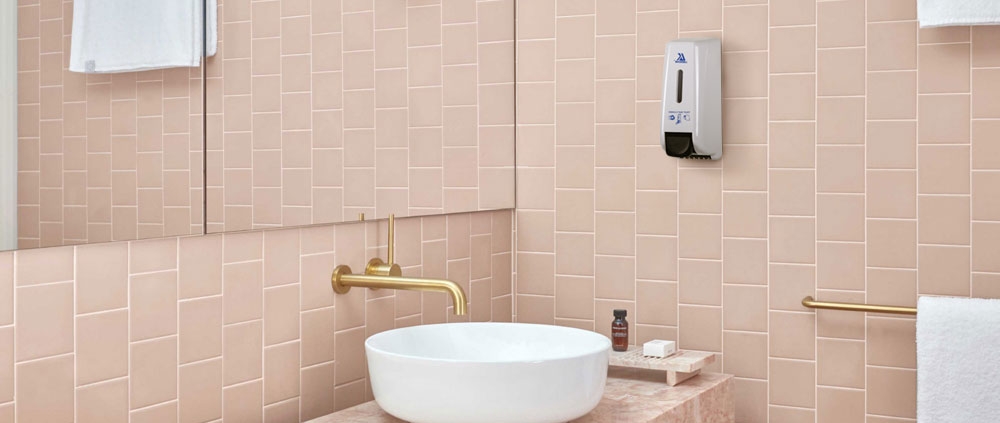At any location within a healthcare facility, where the indication for regular conducting hand disinfection is given, a dispenser must be available. The dispenser must be freely accessible and positioned such, that its usage is easily possible.
Relevant locations for dispensers may be close to or fixed at the patient bed in patient rooms, at the entrance of patient rooms, in examination and procedure rooms, in any specialized medical room dedicated for diagnostic and therapeutic procedures, but also in areas such as preparation rooms for baby formula, aseptic areas such as cornea transplant banks, or blood transfusion units, on trolleys used for storage and transport of wound care products, in the anterooms of isolation units and operating theaters, in sanitary rooms of medically used areas, or at the entrance of hospitals and intensive care units. Provision of dispensers which fulfill the present recommendation in public sanitary rooms used only by visitors is not required. Since, however, also patients and visitors of a healthcare facility should be involved into performing hand hygiene it may be prudent to install dispensers visibly at the entrance area of a healthcare facility or high risk areas such as intensive care units together with easily understandable instructions for hand hygiene, such as in the form of pictograms.
Abandonment of dispensers will automatically result in negligence of hand hygiene practices, since it will be difficult to disinfect contaminated hands during patient care. Pocket bottles can be accepted as a compromise, when dispensers cannot be installed because of difficult architectural situations. Pocket bottles, however, cannot substitute for the adequate availability of dispensers, since they allow hand hygiene only the person carrying the pocket bottle. Regardless of the manufacturer and the design of a hand rub or liquid soap dispenser the following requirements shall be met in healthcare facilities:
Triggering the dispenser must be possible without using hands. Sensor- or elbow-operated dispensers both fulfill this requirement.
Dispensers must be only refillable in a modality where the content, be it a hand rub or liquid soap, cannot be contaminated. This is achieved best by using replaceable cartridge systems. Refilling through “top-up” must not be possible
The dispenser should allow usage of different types of cartridges made by different manufacturers.
Dispensers must be operated and maintained such that a microbial contamination of the pump nozzle may easily be avoided.
It must be possible to identify the products used in a dispenser easily and without any manipulation. Identifying the type of product, be it a hand rub or a liquid soap, as well as reading the product’s name and critical manufacturer warnings must be possible at any time.
The dispenser must allow identification of the level of the used product without any further manipulation at any time.
The design of the dispenser must allow easy cleaning and disinfection the outside and inside of the dispenser. The manufacturer of the dispenser must provide the user with information on applicable chemicals and cleaning products.
It must be possible to reprocess the dispenser and all of its permanent parts by applying machine based thermal disinfection at an A0-value of minimum 60 (e.g., 80°C/1 min).
Automatically portioning dispensers shall not fail during 200 hubs. The maximal allowed failure rate shall not exceed 1% (2 out of 200 consecutive hubs).
A dispenser used for alcohol-based hand rubs must allow keeping the alcohol concentration constant over a time period of 3 months. The maximum acceptable decrease in the concentration of the alcohol shall not exceed 5%.
Liquid soap and hand rub dispensers with single-use pumps, ideally already mounted on the cartridge and to be discharged with the empty cartridge, are preferable. If pumps are used on the next consecutive cartridge, the manufacturer must provide the user with a detailed introduction for cleansing and reprocessing before further use.
Because of forensic reasons it is recommended to place a good readable sign on the dispenser indicating e.g., “Apply alcohol-based hand rubs only on the hand! Do not drink, avoid spraying into the eye or application on mucous membranes”.
It is regarded as an additional benefit, if the dispenser is able to document the consumption of hand rub or the frequency of hubs either mechanically or electronically.
Dispensers filled with alcohol-based hand rub cartridges do not pose a fire hazard in healthcare facilities.
A questionnaire based survey analyzed reported fire outbreaks due to dispensers filled with alcohol based hand rubs among 788 healthcare facilities in Germany . Taking the total time of usage of dispensers into consideration, a total of 25,038 hospital-days were included into the assessment. During this time period, only 7 incidences were reported. The reason for these 7 incidences included negligence (handling with burning cigarettes or candles close to the dispenser), vandalism, and one unsuccessful suicide attempt. A self-infliction of the dispenser was never observed. This observation allows the conclusion that dispensers filled with alcohol-based hand rubs do not pose a fire hazard in healthcare facilities.
Hand hygiene is one of the most important measures to prevent transmission of infectious agents and plays a major role in prevention of infection in any type of healthcare setting. Hand hygiene serves the protection of the patient, but at the same time also the safety of healthcare workers. While requirements for efficacy of hand disinfectants are defined in European norms such as the EN 1500 for hygienic hand disinfection, or EN 12791 for surgical hand preparation, no specific recommendations for hand rub dispensers and liquid soap dispensers have been given yet. Thus, it is the aim to support both, the efforts of the German Society for Hospital Hygiene in the form of instructional videos on hand hygiene together with the Professional Association of German Surgeons (BDC) inaugurated concerted action “Patient protection through Hygiene” as well as the Alliance “Clean Hands Campaign” („Aktion saubere Hände”) by amending hand hygiene issues to a hitherto little noticed and discussed topic: design and functional aspects of dispensers used in healthcare facilities. Therefore, the intention of the present recommendation on soap and hand rub dispensers in healthcare facilities is to close this gap and to foster future improvement of dispenser functionality and design.



